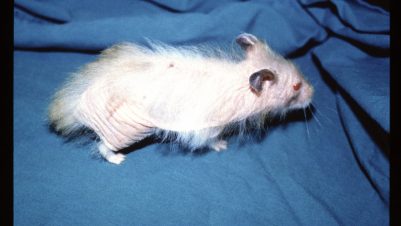Symmetrical lupoid onychodystrophy, or symmetric lupoid onychitis, is a rare disease suspected to be immune-mediated (Miller et al., 2013; Hnilica and Patterson, 2017). Studies in Gordon Setters also suggest a genetic predisposition as DLA class 11 alleles associated with the diseases have been found in this breed (Wilbe et al., 2010). The disease was first described by Scott and others (1995) and these authors suggested the term symmetrical lupoid onychodystropy.
Clinical features
Young to middle-aged dogs are predisposed to the condition. German shepherd and Rottweiler dogs are predisposed, but the condition can occur in any breed of dog. The principal feature of this disease is claw loss (onychomadesis), initially involving one or two claws but within a few months, all claws may be lost. Affected feet are frequently painful.
All four feet are affected but often the front feet more severely (Paterson, 2008). Claws will grow back, but will be misshapen, brittle, discoloured and friable and usually slough subsequently (Hnilica and Patterson, 2017). Paronychia is not a common feature and apart from claw lesions affected, dogs are healthy.
Differential diagnosis
(Hnilica and Patterson, 2017)
- Bacterial claw infection.
- Fungal claw infection.
- Autoimmune skin disorders such as the pemphigus group, systemic lupus erythematosus, or vasculitis (in these conditions, other cutaneous signs are usual).
- Vasculitis.
- Drug eruption.
Diagnosis
To diagnose the condition, you should rule out differentials. History and clinical signs are very typical and it is suggested that they are, in many cases, sufficient to make a diagnosis (Hnilica and Paterson, 2017). Diagnostic histopathological lesions have been described (Scott et al., 1995). This requires P3 amputation and one authority (Hnilica and Patterson, 2017) does not recommend the procedure unless necessary to rule out neoplasia.
Histopathological findings include basal cell hydropic degeneration, apoptosis of individual basal cell keratinocytes, pigmentary incontinence and lichenoid interface dermatitis. These findings are not specific, however, and therefore cannot be completely relied on to make a diagnosis. It has been suggested that they may represent a reaction pattern of the claw to several potential causes (Miller et al., 2013).

Treatment
Removal of all the nails under general anaesthesia has been recommended (Paterson, 2008). It is important to remove the entire nail; sterile dressings are required for 24 to 48 hours. In recurrent or severe cases, P3 amputation may be necessary. Nail trimming should be performed every two weeks.
A variety of medical treatments have been described in the veterinary literature with variable success and are included below. All medical treatments require a minimum of three months to show a beneficial response, but none have been shown to be completely reliable.
- Fatty acid supplementation. Eicosapentaenoic acid (EPA) has been suggested as an effective treatment in some cases. It is given at a dose of 400mg/10mg by mouth daily.
- Vitamin E 200-400 IU by mouth every 12 hours.
- Combined tetracycline/niacinamide may be effective. The dose is 250mg for dogs weighing less than 10kg of each drug every eight hours, and for dogs weighing more than 10kg, 500mg of each drug every eight hours.
- Pentoxifylline 10-25mg/kg by mouth every 12 to 24 hours. n Systemic glucocorticoids. Prednisolone 1-2mg/kg by mouth every 12 hours. n Azathioprine 2mg/kg by mouth every 24 hours.
- Cyclosporine 10 mg/kg for two to three months.
Prognosis
The prognosis for nail growth is good once an effective therapy is established from the list above, although some regrown nails may still be deformed.
Further nail loss and its painful sequelae will be avoided by successful therapy. Treatment may be needed throughout the dog’s life.






-1628179421-401x226.jpg)




